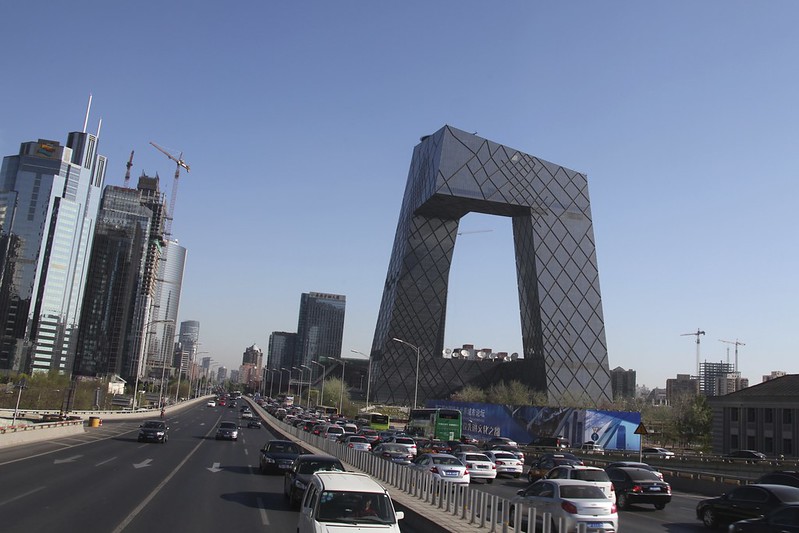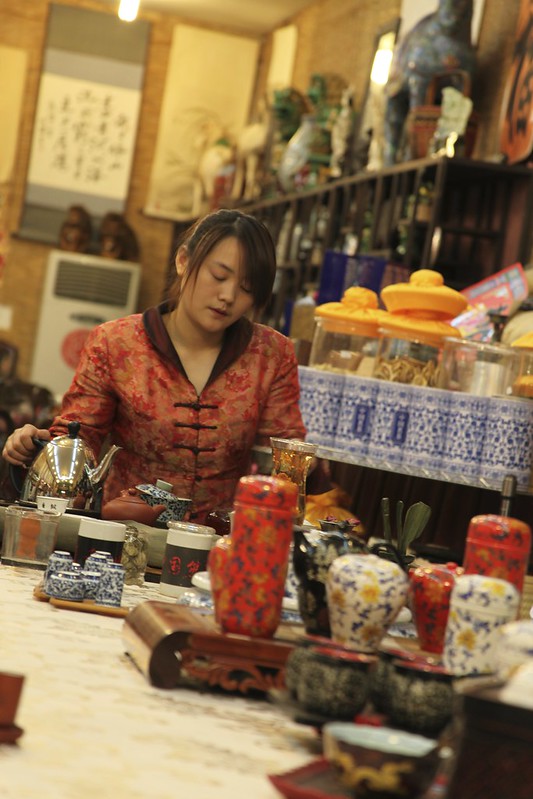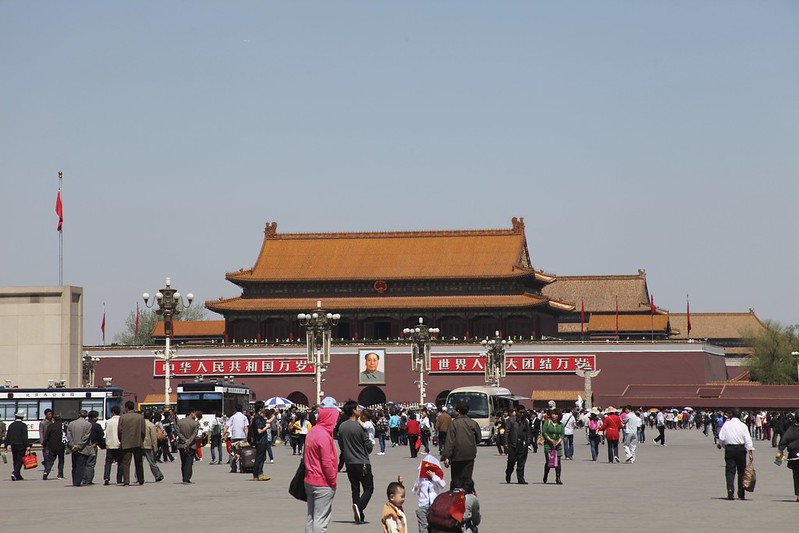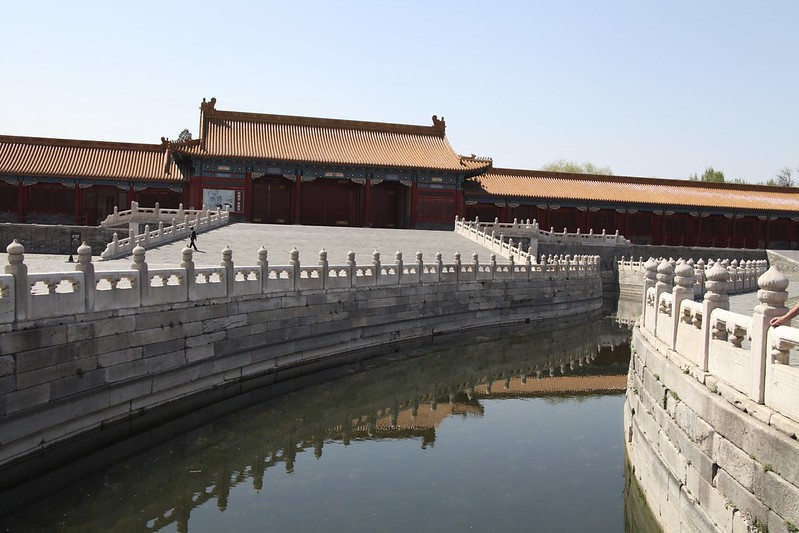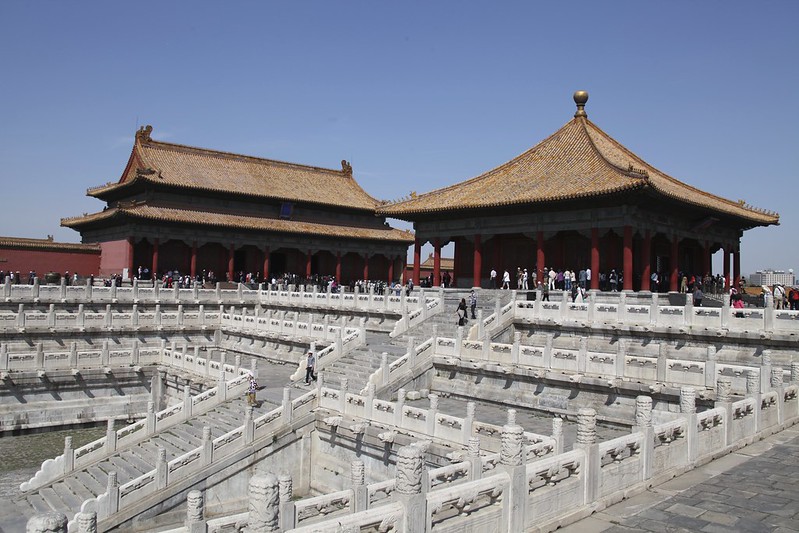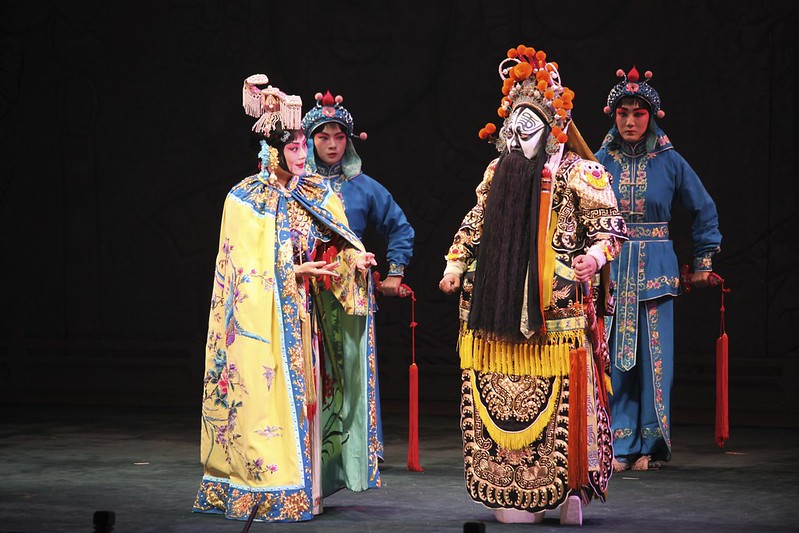Sadly I hadn’t slept that well, but did get at least 4 hours of sleep – an incredible improvement over what sleep I’d been able to get on the plane. During the previous day it had been 29°C and it hadn’t cooled much in the hotel room despite the air con being on all night.
We got the wake-up call at 06:30 and headed straight down for breakfast. The choice was amazing – you could go native and have noodles, spring rolls, etc. for breakfast, or go for the American / English fried breakfast, or even a continental. We both went for a combination of the latter two and had our fill of fruit juices and caffeine before getting ready to head out for our first full day in the country.
The coach journey took around 30 minutes across Beijing allowing us to take in some more of the business district such as the strange looking China Central TV building (which to be honest is an impressive piece of architecture). Before we knew it we’d arrived at the stop for the Temple of Heaven. On the walk to it we went through a park where mostly retired people would socialise as they exercise, dance, play sport, or play cards. On the edge of this park is a covered corridor that leads up to the entrance to the place. There is then a courtyard which has a few buildings around the edge and the main temple building in the middle. It was refurbished just prior to the Beijing Olympic Games in 2008 which means the colours are now quite vibrant.
The Temple of Heaven dates back to the Ming dynasty and was built by the third Emperor. Sadly you’re not allowed inside the main building, but it’s okay to lean through the door and take pictures. I did wonder how much of the building would have been the original work due to the stories of Chairman Mao destroying much of China’s heritage during the time he was in power.
Before heading back to the coach we stopped by a tea house outside the grounds of the temple. There a lady named “Miss Tea” (I’m sure that can’t really be her name) talked about tea traditions in China and the different types of tea. The best of these was the Hulong tea.
When trying tea they fill up a small terracotta thimble with the tea which you use for smelling it, when your ready to try it you put the “cup” over the top, turn it over and lift. From this cup you then taste the teat. There are different ways of holding the cup depending on whether you are male or female.
At the end of the demonstration they did of course try to sell some though I think the entire group declined.
The coach’s next stop was for Tiananmen square, the (in)famous place of protests during 1989, though it had to drop us off around the corner as they don’t allow them to get too close these days. The area is entirely fenced off with low railings and the only entrances are at huts guarded by both police and military. Apparently in addition to these they also have police in plain clothes patrolling the interior of the square. Being part of a British tour group they waved us pretty much straight through without even bothering with the metal detectors. Was a bit of a surprise as I’d taken my backpack off ready to go through the X-ray machine.
In the square we were told how they respected Chairman Mao so much they disrespected his wishes to be cremated at sea and was instead preserved in a crystal casket in a mausoleum they built for him. The mausoleum is only open to the public at certain times of the year and when it is crowds queue for hours to get a chance to see him. Either side of the entrance you will find statues with flags of Mao. In the centre of the square is a monument of the people’s heroes and along one of it’s sides you can also find a museum of Chinese history. On the side of the Forbidden City there is also a flag from which the first flag still flies.
The protests that started with Tiananmen square took place not long after the death of Hu Yaobang and were aiming to encourage the continued economic reform and to stop the corruption that had started to grow in the communist’s party elite. Eventually the government grew tired of the protests and the growing support for them and decided to declare martial law, bringing the military into the centre of Beijing. On the way they were blocked by protesters who were fired at with live ammunition, killing an unknown number of them. Tiananmen was not the only source of protests and violence, but it has become the focal point of those events. To look at the square today the only sign of this history is the security that is now in place.
To get to the Forbidden City we took an underpass due to the busy road to get the first gateway. Entering the first courtyard it didn’t really seem as I expected, though we later found out there were two courtyards before you enter it proper. We went through the first two quite quickly whilst we were taught some history. We then exited to the right where we went to a restaurant for lunch. This was pretty much the same as the evening meal the night before, though with slightly different dishes. By this point it already seemed obvious that the Chinese, or at least this tour, would be full of meals around round tables, with a “lazy susan” which each dish would be placed on. The restaurant seemed a little run-down, but I suspect the choice was down to it’s relatively close position to the city.
The Imperial Palace in it’s current location begun construction in 1406 by Zhu Di and took 15 years and over a million workers to see it to completion. Since then the Forbidden City was the seat of the Chinese empire until the end of the Qing dynasty totalling 24 emperors from the Ming and Qing dynasties. It was occupied during the second opium war and during the Boxer rebellion, but after the abdication of Puyi, the Last Emperor, the outer courts were opened to the new Republic of China. This was until 1924 when Puyi was forced out of the city and the Palace turned into a museum a year later.
The proper entrance to the Forbidden City through the Meridian Gate requires any backpacks to go through x-ray machines, so although it didn’t seem like it, there was some security present to help protect this important piece of history. This then took us to another courtyard. This one had three bridges, the middle of which would have been reserved for the Emperor. The guide explained that in feng-shui, part of their belief system, it is important to have water in the grounds. The entire palace is also surrounded by a moat.
We then worked our way through the crowd to take pictures of the Emperor’s chair in the Hall of Preserving Harmony (after having gone through another gateway). It was a struggle to get some pictures, but we did at least learn that the locals can be very rude and elbow their way past you to get to where they want to be. From the courtyard behind this, next to the Hall of Mental Cultivation, we could see three temples in the distance.
The tour continued along the lower level and into the “Inner Court”, visiting a quiet area with a tree in blossom followed by the Imperial Garden. We walked all around this area but didn’t seem to go in any buildings in the Inner Court – I imagine most of these are actually closed off to the public. We then left through the Gate of Divine Might, and from there it was a 10 minute walk to where we waited for the coach to collect us. Overall we’d walked around 4 miles since we’d disembarked at Tiananmen square. So not really a massive distance, but it was thirsty work in the unusually warm and clear sky of Beijing (normally it is coated in a layer of smog from what we’d heard).
Arriving back at the hotel for 16:00 this provided enough time for a shower before the 17:30 pickup for the restaurant and Peking Opera. At the Beijing Shun Chao restaurant it was again a very similar meal to the previous. By the time we’d left there and got to the performance it had already passed it’s 19:30 start time. The performance seemed to cover a few themes including some swordplay and Kung-fu. The bit that was meant to be singing sounded more like cat being tortured in my opinion.
We left the hotel where the show was just after 21:00 and got back to ours around 21:50.
